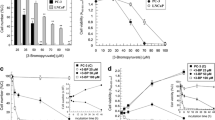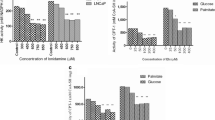Abstract.
A role of glyoxalase I (Gly-I), a detoxifying enzyme, in cell viability of prostate cancer was investigated. Cell extracts obtained from 66 prostate tissue specimens and prostatic cancer PC-3 cells were assayed for Gly-I activity using the spectrophotometric method. Gly-I activity was consistently more than eightfold higher in prostate cancer (CAP) specimens (n=37) than in non-cancerous (NCP) specimens (n=29). To understand the importance of such a high Gly-I activity in CAP specimens, the effects of methylglyoxal (MG) on PC-3 cells were examined in vitro. MG, a putative toxic glycolytic metabolite, was capable of inducing severe (>99%) cell death in 24 h, along with a significant reduction in activities of Gly-I as well as glyceraldehyde 3-phosphate dehydrogenase (G3PDH), a key glycolytic enzyme. However, such severe cell death was effectively (~85%) prevented with N-acetylcysteine (NAC), a precursor of reduced glutathione (GSH) that is an essential cofactor for Gly-I, accompanied by the intact Gly-I and G3PDH activities. Therefore, Gly-I may play a critical detoxifying role in glycolysis to maintain cellular activity and viability of prostatic cancer cells.
Similar content being viewed by others
Author information
Authors and Affiliations
Additional information
Electronic Publication
Rights and permissions
About this article
Cite this article
Davidson, S.D., Milanesa, D.M., Mallouh, C. et al. A possible regulatory role of glyoxalase I in cell viability of human prostate cancer. Urol Res 30, 116–121 (2002). https://doi.org/10.1007/s00240-002-0244-7
Received:
Accepted:
Issue Date:
DOI: https://doi.org/10.1007/s00240-002-0244-7




